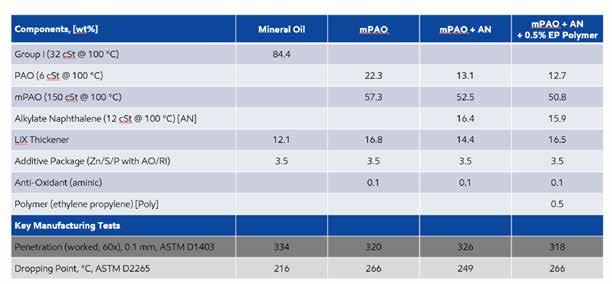
31 minute read
Covering the Bases: A Study of the Influence of Synthetic Base Fluids on High Performance Greases
Luca Salvi, Product Development – Formulation Principal, ExxonMobil Technology and Engineering Company Joseph Kaperick, Technical Advisor – Grease Technology, Afton Chemical Corp.
Abstract
As demand on equipment productivity and reliability continue to increase, it becomes more important to understand the impact of base fluid in improving the performance of lubricating greases under severe conditions, including higher loads and broader operating temperatures. The purpose of this study was to look at the performance of several different lithium complex greases produced with high viscosity metallocene polyalphaolefin (mPAO) base oils. The grease variations incorporated alkylated naphthalene (AN) and employed different additive combinations with the mPAO base fluid and were benchmarked against a mineral oil formulation. Performance of the base greases, as well as fully additized finished greases, were evaluated in a comprehensive study, including a wide range of testing to evaluate high and low temperature performance, elastomer compatibility, and ability to protect against oxidation, wear, extreme pressure, and corrosion.
Background Work
Use of synthetic fluids in greases has grown steadily, rising from the 3% reported in the 2010 grease industry survey (NLGI Grease Production Survey Report, 2011) (the first year in which this category was recorded) to over twice that in the most recent 2021 survey (NLGI Grease Production Survey Report, 2022) with a combined total of over 11% reporting the use of at least some synthetic fluid in their formulations. Although a more detailed breakdown of the types of synthetic fluids is not reported in the survey, it is likely that the majority of the synthetic fluids used are some type of PAO.
The use of PAO base fluid in greases are well documented in the literature beginning at least 40 years ago with a study of synthetic fluids including PAO in several different complex thickeners (Roberts, 1982). Recent work with synthetic base fluids was performed by Fish et al. and covered a range of PAOs and esters in various grease thickeners that were evaluated using standard bench tests (Fish, 2017).
A series of studies focused on metallocene-catalyzed PAO fluids (or mPAOs) were done to evaluate mPAO base fluids in polyurea greases and looked at the impact of including mPAO with PAO on low and high temperature stability (Bessette P. H., Synthetic Grease Formulated with PAO 6 and mPAO-65, 2017) (Bessette P. H., 2018). This work was expanded to aluminum complex greases the following year (Bessette P. H., 2019). Previous work looking at alkylated naphthalenes in grease was conducted by Kumbhar & Hunter and showed some thermal and oxidative stability benefits in lithium complex greases (Hunter, 2020). Polymers have been used extensively in the grease industry to improve mechanical stability of the thickener matrix (Willet, 2020).
Methods and Materials
The project was designed to answer two questions fundamentally: 1) what is the impact of the basestock selection in a high-performance grease and 2) is it possible to design an additive package that can deliver a finished product capable of meeting most of the requirements associated with the traditional GC-LB claim and those of the new HPM specification?
In order to answer these questions, a single additive package was selected to be used at the same treat rate of 3.5% for every candidate. The finished greases were manufactured targeting ISO VG 460 / NLGI #1 basic properties, considering that ISO VG 460 is a fairly utilized grade for heavy duty grease, although ISO 150 to ISO 220 may be more popular for multi-purpose greases, while the NLGI #1 thickness was selected to explore the properties of the candidates at the softer end of the manufacturing window. In this particular study, an initial comparison of NLGI #1 and NLGI #2 candidates was conducted in selected cases.
The candidates were manufactured to analyze the effect of the basestock selection, establishing the baseline utilizing a Group I paraffinic mineral oil, while the other candidates were manufactured with synthetic basestocks, and were named after the most significant feature of the formulation. For example, the grease named mPAO was prepared with both metallocene PAO and conventional PAO 6, but the naming convention in the paper was based on the interest of the authors to look at the effect of the mPAO presence as the determining factor in this product. The reasons that mPAO was selected for this comparison are to be found in its outstanding oxidation resistance, combined with excellent low temperature properties. The next candidate was prepared using the same platform of the mPAO-based grease, including ~20% alkylated naphthalene relative to the base oil mixture, and this candidate is referred to as mPAO + AN in the paper. Finally, the last candidate was defined to assess the potential benefits of utilizing an ethylenepropylene polymer, in order to improve the mechanical stability of the thickener matrix. This product was defined including 0.5% of the ethylene-propylene polymer in combination with mPAO and AN. The exact composition of the polymer is proprietary, but it can be described as a material with low crystallinity and medium viscosity. Additional information regarding the composition of each candidate is shown in Table 1.
Table 1 Grease Candidates
The candidates were all manufactured in two discrete steps, where the base grease was manufactured by ExxonMobil, and the finished grease was prepared by Afton using an available additive package of their choice, which will be described later. To avoid any base grease discoloration the aminic anti-oxidant was dosed in the base grease. The same precaution was not necessary in the case of the mineral oil base grease, because of the presence of small amount of naturally occurring anti-oxidants in the basestock.
The grease soap was manufactured in a 100 pound contactor which was charged with the basestocks, followed by LiOH, 12-hydroxystearic acid and commercially available di-acid complexing agent. The mixture was then heated to a top temperature of about 190 °C under pressure and held for approximately 2 hours. After dehydration, the grease was milled to ensure stable consistency results, then cut back with
additional base oil mixture as needed to meet penetration targets, which in this study, was NLGI #1. (Graham, 2012) It is worth noting that the dropping point of the mineral oil-based candidate was slightly lower than the other greases; therefore, when looking at some of the test results generated with this grease, this factor will have to be considered, particularly when looking at structural stability properties.
When the ethylene-propylene polymer was used, it was charged in the contactor at the same time as the basestocks.
The grease soap obtained was then finished utilizing the same additive package for every candidate, treating it at 3.5%. The additive package used was a commercial package based on ZDDP chemistry and included a primary antioxidant (Table 2). The additive package and required basestock/polymer combinations were added to the base greases, heated to 60 °C for an hour, and then thoroughly blended in a centrifugal mixer.
Table 2 Additive package detail
For the purposes of this study, it was decided to use the test performance profiles from the new NLGI High-Performance Multiuse (HPM) Core specification and Low Temperature (LT) enhanced specification along with the highest performance categories for chassis and wheel bearing greases (GC-LB) as outlined in NLGI’s Specification for Automotive Service Grease (ASTM D4950). Each test line is color coded in green if it is listing a test needed for the HPM or HPM-LT specification, and it is shaded in blue if it is a test only needed for GC-LB. The tests required for both specifications are using a gradient of blue and green. The summary with all the tests that were run, and the limits required by the various specification are listed in Table 3 . The list of tests is further divided in 6 sub-categories to break down the specification according to the general physical properties being evaluated.
Some additional testing was carried out to highlight potential performance differences in low temperature and high temperature stability as well as energy efficiency:
• ASTM D5483 “Standard Test Method for Oxidation Induction Time of Lubricating Greases by
Pressure Differential Scanning Calorimetry” - Samples were tested at 180 °C under 500 psi (3,447 kPa) oxygen atmosphere. The extrapolated onset time was measured and reported as the oxidation induction time (OIT) for each sample. • FAG FE9, DIN 51821-T2 - This high temperature bearing rig test uses five separate angular contact ball bearings (ISO 7206) packed with the test grease. The test conditions employed were 1500 N axial load, 6000 rpm and both unshielded (mode A) and shielded (mode B) methods as indicated during discussion of the results. Failure of the bearing occurs when the bearing torque rises above the preset limit indicating that the lubricating grease is losing its ability to effectively lubricate the bearing. A 10% (L10) and 50% (L50) “grease life” is calculated using Weibull statistical analysis of the five bearing runs. This number is an indication of when 10% or 50%, respectively, of the bearings are expected to have failed under the conditions of the test. According to DIN 51825 and ISO 6743, guidance for the maximum operating temperature of the grease can be determined by the temperature at which an L50 of greater than 100 hours is obtained in the FE9 test.
• Low Temperature Flow, Kesternich, DIN 51805 – While the HPM + LT enhanced category only specifies performance targets at -30 °C, the low temperature limits of the grease formulations were further explored at both -40 °C and -50 °C using the same methodology. • ASTM D5707 “Standard Test Method for Measuring Friction and Wear Properties of Lubricating
Grease Using a High-Frequency, Linear-Oscillation (SRV) Test Machine – Samples were tested using the Optimol SRV ball-on-disk method to measure the coefficient of friction during the test run under 200 N load for 2 hours at 50 Hz and 80 °C.
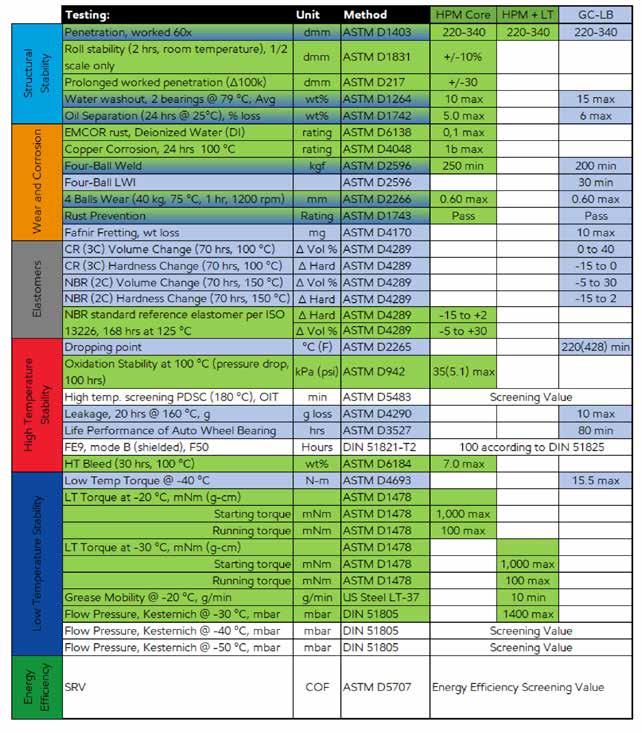
Table 3 Product profiles and industry claims
The candidates that were prepared as part of this study were not optimized to meet all the requirements of the GC-LB and HPM Specifications. Where possible, when failing and/or borderline results were generated, an explanation for that behavior was offered and a potential solution suggested. Furthermore, since the candidates were designed with the same thickener system and with a fixed additive package, that did not allow for the optmization and/or improvements usually associated with the development of a package for a mineral oil-based grease. In fact, in a qualification program designed to utilize mineral basestocks, the additives are carefully tailored to compensate for some of the deficits associated with the basestock fundamental properties.
Results and Discussion
Structural Stability The grease candidates were initially compared looking at the Roll Stability (D1831) and Prolonged Work Penetration (D217). All the candidates were capable of meeting the HPM limits, with the exception of the Mineral Oil-based grease which provided borderline performance in the prolonged worked penetration test. However, the result was just marginally above the limit of 30 mm/10 so it is reasonable to expect that with very minor adjustments this problem could be addressed. The one trend that is apparent looking at the results of these two tests, also summarized in Figure 1, is that all the synthetic-based greases have better structural stability compared to the mineral oil-based grease. The expectation is that greases with higher NLGI grade would also have better structural stability.
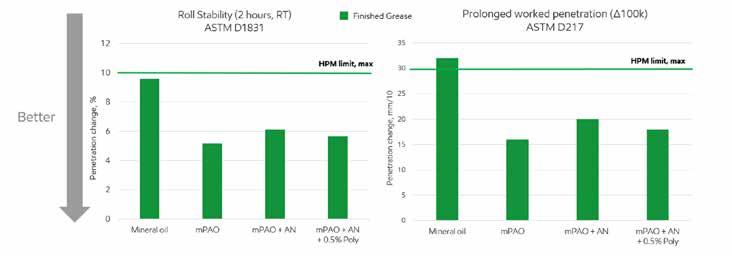
Figure 1 Roll Stability (ASTM D1831) and Prolonged Worked Penetration (ASTM D217) Next, the grease candidates were evaluated to assess the water washout performance, which is a test that has different passing limits set for GC-LB and for HPM, where the latter is more stringent (see Figure 2). All candidates were able to meet the GC-LB limits, while the mineral oil-based grease and the one with mPAO/ AN were borderline failing against the HPM limits. This may be explained by the higher polarity of these two candidates. The mineral oil-based grease is more polar due to the presence of the heteroatoms and the naphthenic rings, while the mPAO/AN candidate is more polar due to the presence of almost 20% alkylated naphthalene. The softer consistency of the mineral oil grease may also be a factor. It is also worth pointing out that the mPAO/AN candidate debit can be addressed in two ways: 1) Increasing the thickness going from NLGI #1 to NLGI #2 2) Increase structural stability by adding 0.5% of the ethylene-propylene polymer
Figure 2 Water Washout (80 °C) ASTM D1264 The last test that was run in the initial structural stability assessment was the Oil Separation according to ASTM D1742. As it can be seen in Figure 3, all the candidates are performing quite well. In fact, all greases are able to meet the GC-LB requirements, while only the mPAO based grease sample is borderline failing to meet the HPM specification requirements. This can be likely explained by the less polar nature of this candidate that makes it more prone to separate the oil from the thickener matrix. However, since the result is so close to the limit, the oil separation performance could be tuned accordingly. In this case we did not observer a difference in performance between the same type of candidate mPAO + AN in two different NLGI Grades (1 vs. 2). This is not a surprise though, since the oil separation is associated with the ability of the basestock to separate from the grease matrix, and if the matrix and the basestocks are the same, we should expect very similar responses. Finally, looking at the effect of introducing the EP Polymer in the mPAO + AN matrix we can observe how the more mechanically stable thickener matrix is now increasing the amount of oil separation as compared to the same candidate without the EP Poly (mPAO + AN NLGI #1). The result is in line with what was expected, but still well within both GC-LB and HPM Limits. This learning could allow a formulator to define the amount of oil separation desired for a given application by titrating a certain amount of EP Polymer.
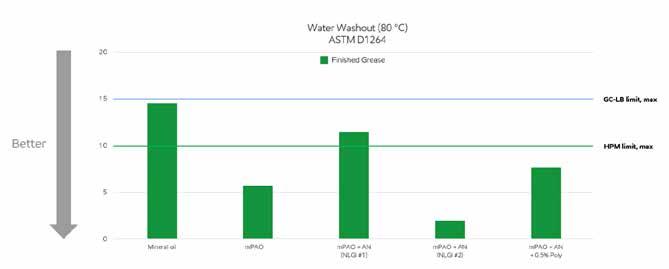
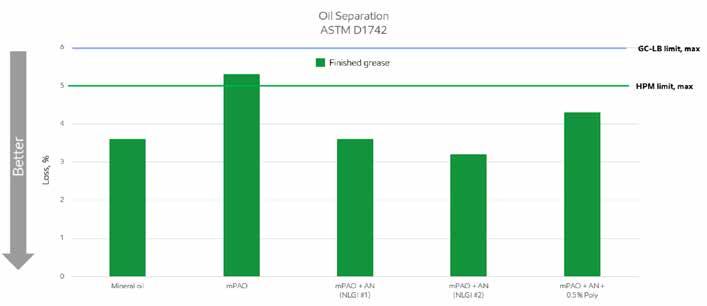
The summary of all the Structural Stability tests that were run is shown in Table 4 including additional tests required by the specifications, but in interest of time, were not analyzed in this article. The color coding indicates whether the test grease met the specifications, being mindful that in some cases the limits may be different for GC-LB and HPM requirements. The green cell indicates that the candidates were capable of meeting each necessary requirement, while an orange shaded cell is used to indicate that some borderline results were obtained against one or more limits. Finally, the red cells are being used when the candidates generated results failing to meet the limits beyond the reproducibility or variation of that particular test.
This summary table will be provided at the end of each individual performance section as a graphical representation of the candidates’ performance.

Table 4 Structural Stability Tests - Summary
Wear/Corrosion The results from the EMCOR corrosion test (Figure 4) indicate that the base grease made with only mPAO (blue columns) has a better corrosion resistance than the other base greases. This may be due to the nonpolar nature of the mPAO base fluid, as compared to the varying degrees of polarity brought with the alkylated naphthalene and mineral oil formulations. This polarity may lead to the incorporation of water into the grease and encourage more corrosion during the week-long test. The mPAO formulation may be more effective in repelling the water and keeping it off the bearing surface.
The additized greases all showed a marked improvement due to the rust inhibitors contained in the additive package. The only significantly different results are seen in the formulation containing alkylated naphthalene possibly due to competition with the polar corrosion inhibitors or incorporation of water as seen with the base grease. In either case, the addition of the polymer appears to negate that impact and would be a good formulation adjustment if using AN to meet the HPM specification in a finished grease.
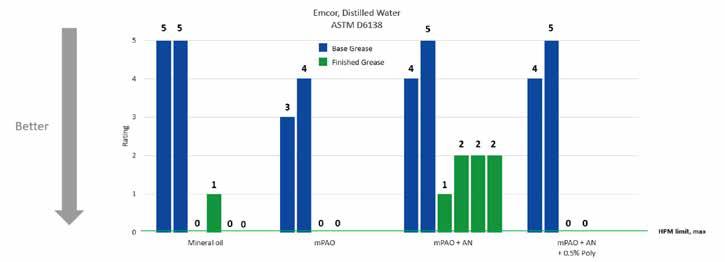
Figure 4 EMCOR corrosion test results
In the case of copper corrosion (Figure 5), there is a slight indication that the AN in the base grease could be detrimental to copper, but the additive package appears to overcome any negative impact from that base grease. Interestingly, the mineral oil-based grease showed no corrosion until it was additized. It is possible that the sulfur from the additive package, in combination with the sulfur from the mineral oil, are combining to have a negative effect which would need to be addressed with a copper corrosion inhibitor to meet the HPM specification if this approach was followed for a finished grease.
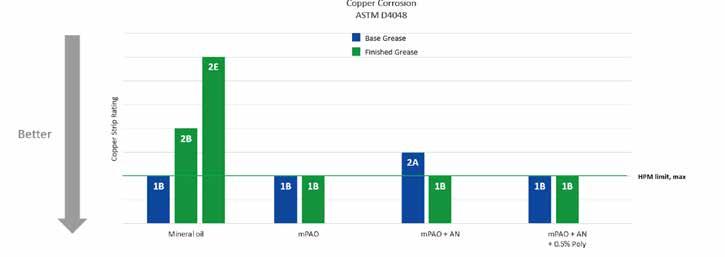
Figure 5 Copper corrosion test results In terms of the ability to protect against extreme pressure, the impact of the sulfur EP componentry in the additive package is apparent (Figure 6). None of the base grease formulations are capable of meeting the bare minimum of 200 kg required by GC-LB; whereas all four additized formulations are able to meet or exceed the higher HPM specification of 250 kg. The higher weld point seen with the mineral oil formulation may well be due to the additional sulfur contributed by the base fluid.
From the wear testing (Figure 6), it can be seen that the mPAO/AN combination appears to be not as good at preventing wear in the base grease, but all additized formulations respond well to the ZDDP anti-wear componentry in the additive package with all four additized greases comfortably meeting the HPM specification limits.
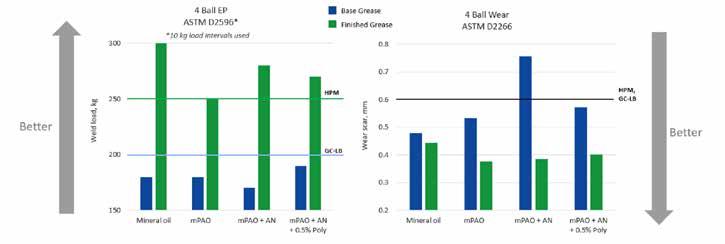
Figure 6 4 Ball weld and wear results
Although most of the additized greases met the wear and corrosion specification limits, the level of performance could be adjusted by optimizing the balance of additive componentry as needed. As seen in the mineral oil formulation, the presence of additional sulfur and other polar components may be causing problems with copper or steel corrosion. It can also be a benefit in protecting against extreme pressure. Likewise, the addition of AN may have a negative effect on steel or copper corrosion or wear protection, but the formulation targets can be met by additization or the use of the polymer in the base grease, according to need.
In summary, as it can be observed in Table 5, all the grease candidates that were analyzed in this study were capable of meeting most the requirements associated with wear and corrosion performance. This is a demonstration of the importance of the selection of the proper additive package, tailored to the targeted performance characteristics.

Table 5 Wear/Corrosion Tests - Summary
Elastomer compatibility Elastomer compatibility is a key performance area to carefully assess in the development phase of a new grease candidate to verify the impact of the additive package and the base fluid composition. In this study, the grease formulations were tested against the more conventional chloroprene and nitrile materials from the GC-LB specification, as well as against the different nitrile elastomer specified in the new HPM specification.
All the grease candidates evaluated in this study met the GC-LB limits for volume and hardness change as can be seen in Figure 7. Not surprisingly, the mPAO-based candidate is the one that showed less swelling as can be seen from the lower volume change and higher level of hardness change. This is a known effect associated with the use of less polar basestocks. However, the addition of alkylated naphthalene brought the performance of these synthetic candidates to the same level of performance of the mineral oil-based candidate.
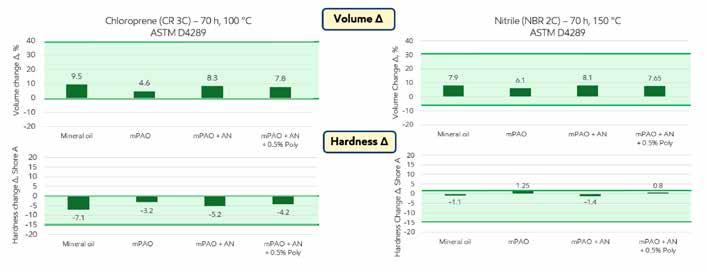
Prompted by the positive results obtained with the conventional chloroprene and nitrile seals, the grease candidates were also tested against the new nitrile material as outlined in the HPM specification (See Figure 8), and again all the candidates met the stated limits. However, it was interesting to see that the mineral oil candidate displayed lower volume/hardness change compared to all the synthetic candidates, and particularly compared against the mPAO-based grease. This is a result that deserves further study to understand the root cause.
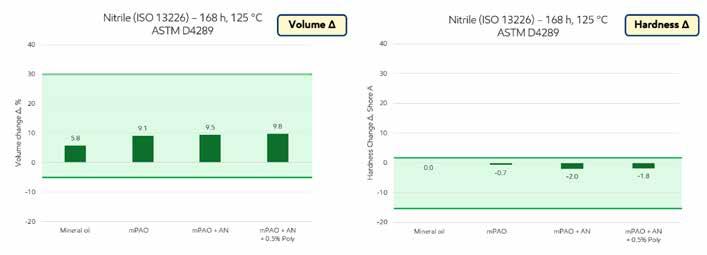
Figure 8 Seals Compatibility (Nitrile ISO13226) The elastomer compatibility study did not highlight any significant concerns associated with either the base fluid or additive package composition, as is reflected in Table 6.

Table 6 Elastomer Compatibility Tests - Summary
High Temperature Stability All 3 of the mPAO-containing base greases showed better oxidative stability in the PDSC testing (Figure 9) than the mineral oil formulation, but they also had oxidation induction times of less than 10 minutes, so it is difficult to attach too much significance to those results. They do mirror the trend of results seen for the additized greases based on the mineral oil giving a result that was roughly half of what was seen for the mPAO formulations. This test is not part of the HPM or GC-LB specifications but can be a good indicator of oxidative stability at higher temperatures and performance could be optimized by balancing the antioxidant levels in the formulations.
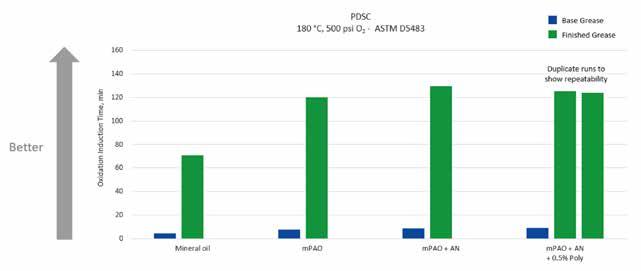
Figure 9 Pressurized Differential Scanning Calorimetry (PDSC) test results A measure of high temperature structural stability is the ASTM D4290 Leakage Tendency test (Figure 10) and the mPAO formulations all respond better than the mineral oil-based grease under these conditions. The mineral oil-based grease did not meet the GC-LB specification limit, but this is also likely due in some part to the fact that this is a softer NLGI #1 grease which would not be expected to do as well in this test. Use of a stiffer, higher NLGI grade, or the mPAO formulations, would be indicated if improvement was needed in this category.
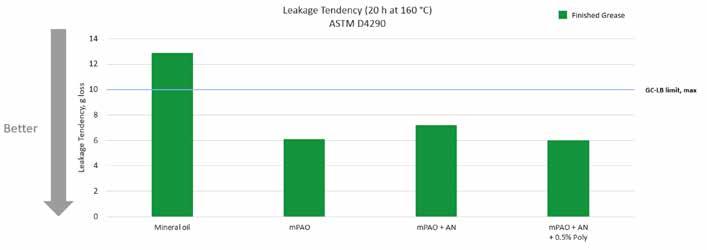
Figure 10 Leakage tendency test results High temperature bearing tests are generally regarded as better indicators of a grease’s high temperature capabilities since they simulate the action of a grease in an actual bearing under conditions that are closer to “real world” applications. The High Temperature Wheel Bearing test, or HTWB, (ASTM D3527) is one such bearing test and, although variability is problematic, it can still be a good differentiator of grease performance in high temperature applications. While not all the results (Figure 11) are significantly different, the general trend is clear with the mineral oil-based grease performing the worst and not meeting the GC-LB specification limit. All three of the mPAO formulations meet or exceed the specification limits with clear indications that the AN-containing greases have additional strength in this test.
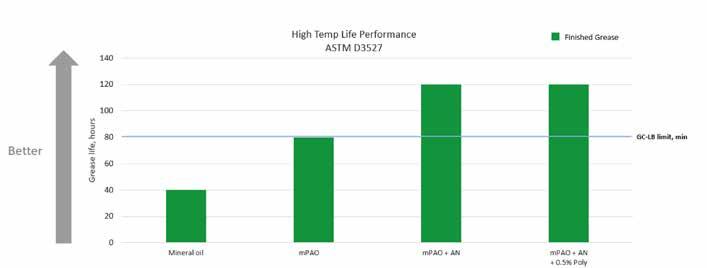
Figure 11 High Temp Life Performance (ASTM D3527) results Another high temperature bearing test is the FAG FE9 test. The variability of this test is somewhat improved by the fact that each test uses 5 bearings, run to failure with Weibull statistics being used to determine the F50 for the test grease. The F50 is the time under test conditions that 50% of the bearings will be expected to fail. The test can be run at a variety of temperatures, depending on intended application with the target performance (according to DIN 51825) being 100 hours minimum at the target temperature. It can also be run without shields (mode A) or with shields (mode B). The shields are typically used in field applications that run at higher temperatures and help to keep the grease in the bearing. This can help extend the life of the grease in the FE9 test (as it would in the field) but they are not yet accepted under the DIN 51825 specification.
The FE9 test was run first at 140 °C in mode A and, in this case, an NLGI Grade 2 version of the mPAO/AN formulation was able to run as well (Figure 12). The results, while not statistically significant, do point toward better performance for the stiffer grade which would be expected due to the increased ability of the grease to stay in place. This same phenomenon can be seen in the mPAO/AN-based grease in which the addition of the EP polymer results in 50% longer life in this test.

Figure 12 FE9 High Temperature Bearing test results, 140 °C The test was repeated at 160 °C, although in this case, mode B was used due to the softer nature of the grease and the higher test temperature. Similar behavior can be seen in this set of results (Figure 13) with the NLGI
Grade 2 grease giving results that are 10% higher and the addition of EP polymer resulting in a 10% longer life as well. The mPAO containing formulations appeared to perform much better than mineral oil-based benchmark product. While in line with expectations from other thermal and oxidative stability testing, this testing would need to be repeated to confirm statistical significance.
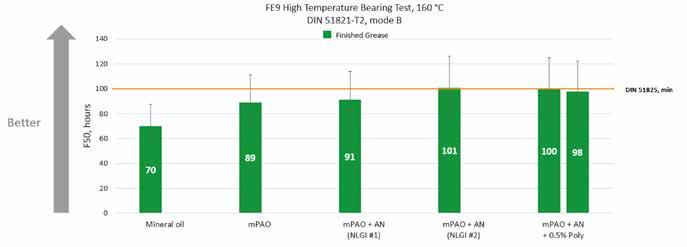
Figure 13 FE9 High Temperature Bearing test results, 160 °C Overall, as seen in Table 7, the mPAO-based formulations appear to outperform the mineral oil-based formulation in most high temperature aspects. As expected, the oxidative stability of the mPAO formulations is better than mineral oil, but the addition of AN and the EP polymer appears to give it an extra boost in performance in the high temperature bearing tests. Additionally, there is some indication that the firmer NLGI Grade 2 grease gives longer life results than the softer NLGI Grade 1 in the FAG FE9 test. Additional testing would be needed to confirm this finding, but it would fit well with results showing that the addition of EP polymer seems to enhance the overall high temperature stability of the grease as seen in leakage tendency and the rig tests.

Table 7 High Temperature Stability - summary
Low Temperature Stability The low temperature stability testing includes some more stringent requirements associated with the HPM + LT specification and not just with GC-LB and HPM core.
The first test that was considered in this section is the Grease Mobility at -20 °C (US Steel LT-37) which is only necessary when targeting HPM + LT performance (Figure 14). The only candidate that is capable of passing this test is the synthetic grease prepared with alkylated naphthalene. The excellent result of this candidate is likely due to the polarity provided by the AN in combination with a generally superior low temperature performance offered by the synthetic base oil mixture. Additionally, and not surprisingly, it’s evident in this case that there is a deficit associated with the presence of the ethylene-propylene polymer in this performance area.
Finally, the known disadvantages of mineral oil products in low temperature performance come to the forefront, and in this instance, are likely due to the formation of waxy networks that severely affect the mobility of the grease.
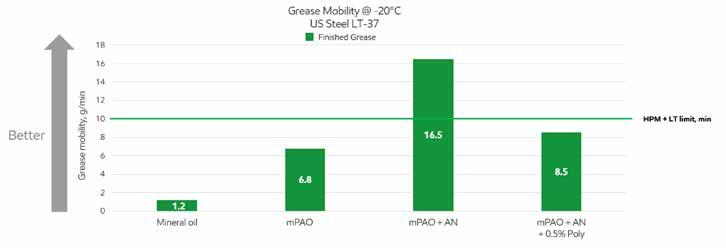
Figure 14 US Steel LT-37 The low temperature ball bearing torque test is required by both HPM Core and by HPM + LT. In Figure 14, the results are summarized showing the initial torque on the left, and the running torque on the right. All the candidates are capable of meeting the requirements at -20 °C (HPM core conditions), but it’s apparent that the mineral oil offers lower performance compared to all the synthetic-based products. When the temperature is lowered to -30 °C (HPM + LT conditions), all the synthetic-based greases are still capable of meeting the HPM limits, while the mineral oil-based grease exceeds the limits significantly.
Figure 15 Low Temperature Ball Bearing Toque Finally, the Flow Pressure Kesternich test was run at -30 °C, -40 °C and -50 °C, although the HPM + LT specification only requires the test to be run at -30 °C (Figure 16).
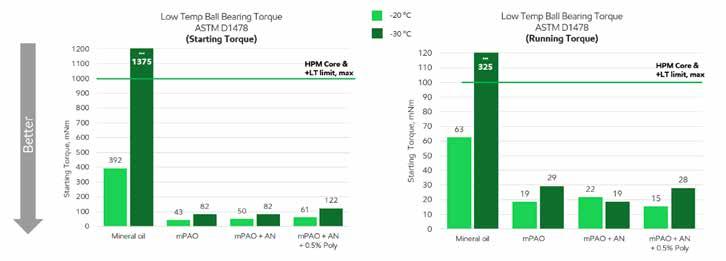
This test can predict the performance of the grease under very challenging low temperature conditions. The mineral oil-based grease is not capable of meeting the HPM limits at -30 °C, while the synthetic-based greases can meet the requirements both at the specified temperature of -30 °C, and also at -40 °C. To further demonstrate the difference amongst the synthetic based greases, a test was also run at -50 °C, and under those conditions
the mPAO-based grease is the only one that is still capable of meeting the HPM+LT limits (see Figure 16). It is clear from this experiment that balancing the formulation is the key challenge when formulating a new grease, particularly when targeting extreme conditions, such as low and high temperature performance. What can help to improve performance in one area, like the ethylene-propylene polymer in high temperature tests, can also have a negative impact in the low temperature tests such as the Flow Pressure Kesternich or the US Steel Mobility.
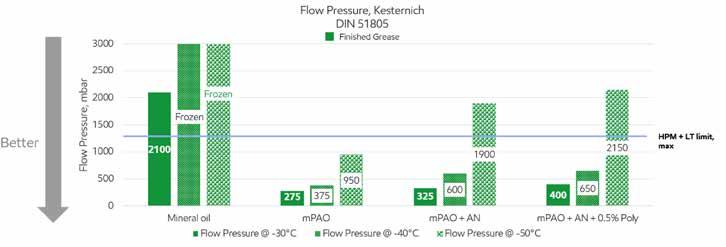
Figure 16 Flow Pressure Kesternich - DIN 51805 All the results generated in the Low Temperature section are summarized in Table 8. In this performance area, the benefits associated with the selection of a synthetic basestock become more apparent. Each of the synthetic candidates displayed some borderline performance, but the purpose of this study was not to develop a grease capable of meeting all the requirements of a given specification, but to demonstrate the effects of the basestock selection in a given performance category.
Particularly in this section, the performance deficit associated with the use of the ethylene-propylene polymer, which at low temperature can affect the matrix stiffness, becomes more apparent.
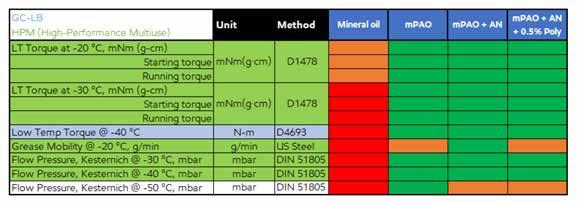
Table 8 Low Temperature Tests - Summary
Energy Efficiency Energy efficiency of grease formulations are of great interest when discussing sustainability of grease formulations. Although there are no readily available test rigs for comparing energy efficiency of different finished greases, comparison of coefficient of friction (COF) can be an initial proxy indicating potential differences that could be realized in applications.
The SRV friction test (ASTM D5707) showed significant differences between the greases studied (Figure 17). The mineral oil formulation gave a significantly higher COF for the duration of the 2-hour tests. The COF for the mineral oil formulation was over 10% higher than the mPAO and mPAO/AN-based formulations. The EP polymer may have slightly raised the COF of the mPAO-based formulation, but it still ended up over 5% lower than the mineral oil formulation.
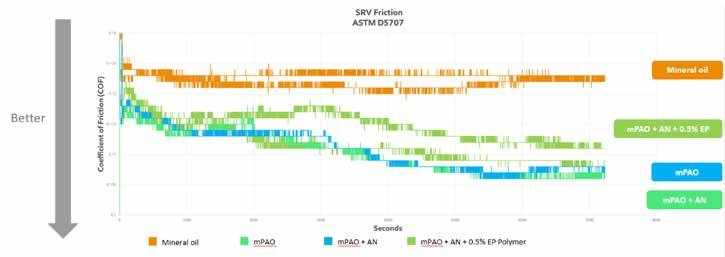
Figure 17 SRV Friction test results – mineral oil vs mPAO Additional testing compared the NLGI Grade 2 and NLGI Grade 1 greases (Figure 18). This comparison shows that the change in grades results in a COF that is about 13% higher for the thicker NLGI Grade 2 grease. This is unsurprising given the increased amount of thickener present in the NLGI Grade 2 grease, but the comparison also shows that the use of mPAO with AN in the grease formulation gives a drop in COF which is equivalent to the incremental change in grade from NLGI Grade 2 to NLGI Grade 1.
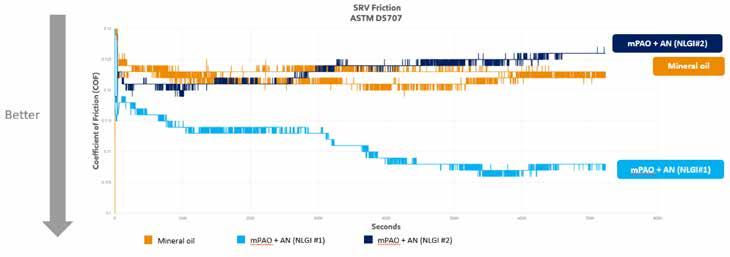
Figure 18 SRV Friction test results – NLGI Grade 2 vs NLGI Grade 1
Summary and Conclusions
In summary, this study systematically examined different basestocks which were selected with regard to how they might affect the properties of a finished grease. These were primarily chosen to compare mineral oil with mPAO-based formulations. Additionally, the impact of the additive package on those different base greases was evaluated using the GC-LB and HPM specifications [Table 9] as a benchmark.
Structural stability was clearly superior within the group of greases manufactured with a synthetic basestock. The mineral oil-based greases can meet the necessary requirements easily as well, even if in this study they were technically failing to meet certain parameters. The authors believe that those concerns could be addressed simply by optimizing the manufacturing process and/or formulations. There are indications that the NLGI Grade is more important in this area than in some others with one data point indicating a large improvement in water washout with an NLGI Grade #2 formulation. The presence of alkylated naphthalene did negatively impact the water washout performance, likely due to the increased polarity of this base oil mixture. The addition of an ethylene-propylene polymer was beneficial to water washout performance even in the presence of alkylated naphthalene.
In the area of wear/corrosion, the effect of mineral oil may be positive in some respects such as extreme pressure, but could be offset by negative impacts on copper corrosion or wear. Alkylated naphthalene may lead to some deterioration of corrosion protection, but the EP polymer seems to eliminate this negative effect. Overall, the need for balanced additive formulation to meet the desired performance targets is key.
Elastomer compatibility was excellent across the board, but further study would be necessary to understand why the conventional seals and the new HPM nitrile seals had an opposite response when tested with greases containing mPAO. In fact, the new HPM nitrile seals displayed more volume/hardness variation when tested with the synthetic-based grease as compared to the mineral oil-based grease.
The expected benefits of synthetic fluids were especially visible in high temperature attributes. The oxidative and thermal stability detriments of mineral oil formulations were obvious and translated into poor performance in the high temperature bearing tests. While mPAO-based formulations were better in these aspects, the inclusion of alkylated naphthalene and/or EP polymer seemed to give benefits, especially in the HTWB and FE9 testing.
The well-known low temperature properties of PAOs were also apparent in the grease formulations incorporating the mPAO fluid combinations, although some attention should be paid to the possible impact of EP polymer and AN balance in a finished formulation depending on the properties desired. The US Steel mobility test may need AN to pass the HPM + LT specification, but the EP polymer (which helps high temperature performance) may be detrimental.
Energy efficiency benefits may be indicated by the significantly lower coefficient of friction seen with the mPAO formulations, although as in the low temperature performance, the EP polymer may negate some of those advantages.
Overall, the findings here should be a guide for the positive and negative impacts of different styles of formulation with great care being needed to meet desired performance targets. The data shown here indicates that with the proper choice of base fluid and additive combinations, high performing finished greases can be formulated that meet the performance levels of NLGI’s new HPM core specification and its enhanced performance categories.
Table 9 Overall Performance Summary
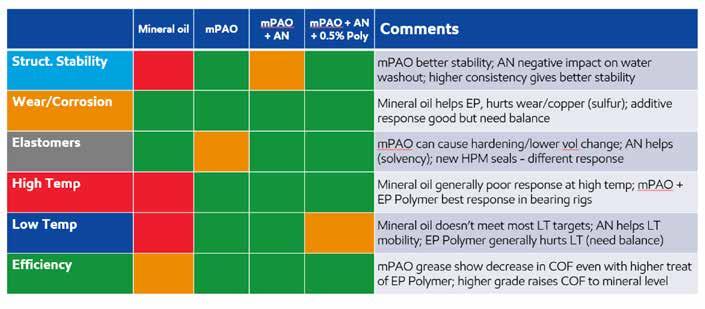
Future work
Additional work will focus on the comparison of the performance of the same set of greases analyzed in this study, looking at candidates manufactured in the NLGI Grade 2 class. Such a systematic comparison could help to understand how to move the needle further in all the critical tests, where the thickness of the grease may play a more substantial role.
Further studies could be focused specifically to understand the FE9 high temperature performance utilizing the same NLGI Grade 2 grease, diluting it to the corresponding NLGI Grade 1 candidate. This, in turn, will remove some of the variability associated with the manufacturing process.
Additional study is also planned to evaluate the balance needed to optimize specific performance areas with different combinations of base fluid, polymer and additive and, perhaps, in different thickener types. Evaluation of the differences in response to additive systems seen between mPAO and mineral based grease formulations is also of interest.
Finally, further exploration of potential differences in energy efficiency and better ways to measure these differences could be very beneficial in real-world applications.
Works Cited
Bessette, P. H. (2017). Synthetic Grease Formulated with PAO 6 and mPAO-65. NLGI Spokesman, 38-48. Bessette, P. H. (2018). The Preparation of a Polyurea Grease using mPAO 65 and Preformed Diurea. NLGI Spokesman, 40-50. Bessette, P. H. (2019). The Preparation of an Aluminum Complex Grease Formulated with PAO 6 and mPAO 65. NLGI Spokesman, 28-38. Fish, G. H. (2017). Technologies to Enhance Synthetic Lubricating Greases. NLGI Spokesman, 24-34. Graham, D. K. (2012). The STRATCO Contactor Reactor Method of Grease Manufacturing. Lubrisense, 13. Grease Technology Solutions, LLC. (2011). NLGI Grease Production Survey Report. Liberty, MO: NLGI. Grease Technology Solutions, LLC. (2022). NLGI Grease Production Survey Report. LIberty, MO: NLGI. Hunter, M. K. (2020). Alkylated Naphthalenes for High Temperature Applications. NLGI Spokesman, 42-52. Roberts, J. W. (1982). High Dropping Point Grease Thickeners in Synthetic Fluids. NLGI Spokesman, 157-167. Willet, E. (2020). The Mechanical Stability of Polymer-Modified Greases. Spokesman, 6, 6-16.






